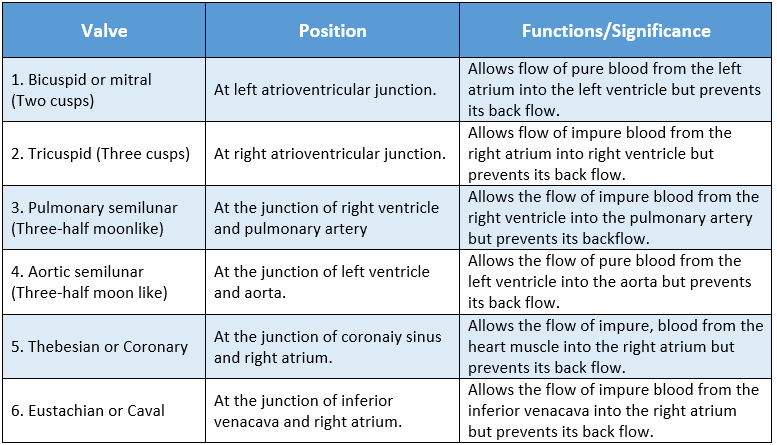Chapter 3 Physiological Processes Of Life Circulation Long Answer Type Questions
Question 1. Define circulation and mention the importance of circulation in living organisms.
Answer:
Circulation:
Circulation is the physiological process by which nutrients, respiratory gases, hormones, and metabolic waste matters are transported within a body through a fluid medium.
Importance of circulation:
WBBSE Life Science And Environment Class 9 Solutions
Circulation is important for living organisms as it plays the following roles:
- Movement of nutrients and minerals: Water, essential minerals, and food materials are transported to all tissues of a living body by means of circulation.
- Transport of respiratory gases: Respiratory gases, such as O2 and CO2, are transported within the body through the process of circulation.
- Removal of metabolic wastes: The unwanted matter, produced in the cells from metabolic activities is transported from the tissues to excretory organs for elimination.
- Movement of synthesized materials: Hormones, synthesized in cells, are transported to their target organs by means of circulation.
- Maintenance of heat: Circulatory fluid maintains the body heat in warm-blooded animals.
- Storage: Amino acids are stored in the circulatory fluid (blood) to form an amino acid pool. Some lipids (cholesterol) are also stored in the blood.
Read and Learn More Class 9 Life Science Long Answer Questions
Question 2 Give a brief account of the different components of the human circulatory system.
Answer:
Components of the human circulatory system:
The human circulatory system is composed of three major components:
1. Circulating fluids
2. Vessels
3. A pumping organ (heart).
Circulating fluids: Blood and lymph are the circulating fluids of the human circulatory system.
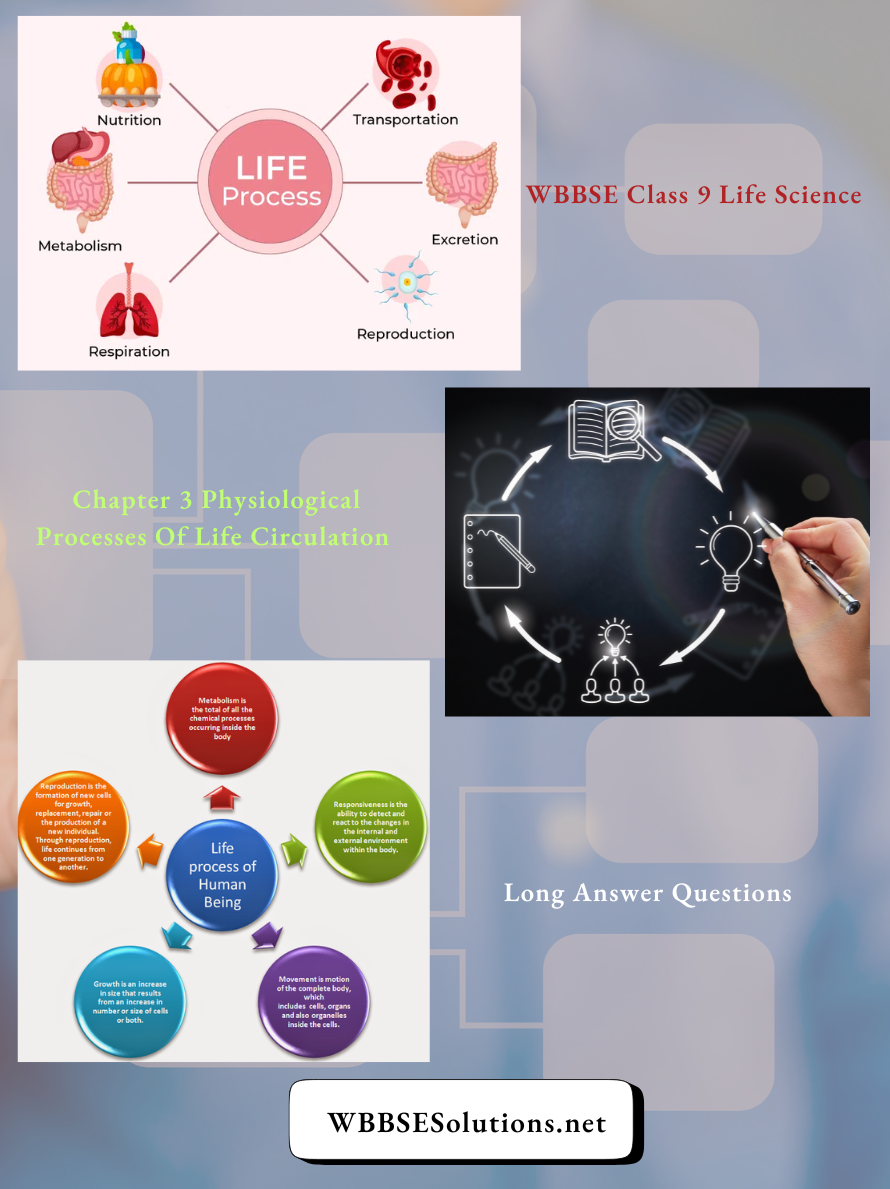
1. Blood: Blood is the red-colored fluid connective tissue, which carries different important materials through the blood vessels.
2. Lymph: Lymph is a special tissue fluid that flows through the lymphatic ducts, and lymph glands. It acts as another transporting medium apart from blood.
Vessels: Blood flows through three types of vessels, which form an intricate network in the human body. These are arteries, veins, and capillaries.
1. Arteries: Arteries are thick-walled vessels with roundish lumen. They carry oxygenated blood (except pulmonary arteries) from the heart to the tissues. Arteries show rhythmic pulsation.
2. Veins: Veins have thinner walls and flattish lumen. Veins carry deoxygenated blood (exception-pulmonary vein) from the tissues to the heart. They have valves to maintain the unidirectional blood flow.
3. Capillaries: These are very thin-walled blood vessels present between the arteries and the veins. These fine vessels reach deep into the tissues.
Heart: It is a muscular, four-chambered sack-like structure, which pumps blood continuously into arteries and helps blood to flow through the network of vessels in the human body.
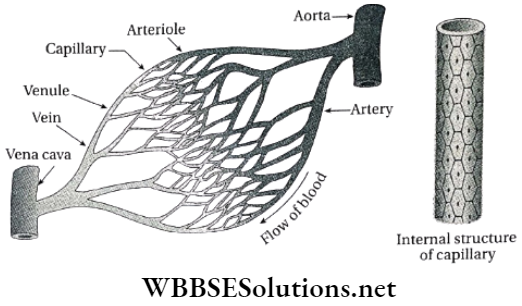
WBBSE Life Science And Environment Class 9 Solutions
Question 3. Schematically mention different types of blood corpuscles of the human body.
Answer:
Different types of blood corpuscles or cells of the human body:
Question 4 Mention the functions of lymph, cerebrospinal fluid, and sweat.
Answer:
Functions of lymph:
The functions of lymph are as follows:
1. It supplies nutrients and oxygen deep into the tissues
2. Lymphocyte cells and antibodies present in the lymph, kill germs
3. Absorbs fat from the Intestine
4. It collects the metabolic wastes from the tissue fluid
5. Lymph maintains pressure, volume and composition of the tissue fluids.
Functions of cerebrospinal fluid:
The functions of cerebrospinal fluid are mentioned below:
1. Acts as a shock absorber for the brain & spinal cord
2. Supplies nutrition and oxygen to the brain tissue
3. Helps in the removal of metabolic wastes from the CNS.
Functions of sweat:
The functions of sweat are as mentioned below:
1. It maintains the acid-base balance, water balance and the body temperature.
2. Some salts, urea and many other materials are excreted through sweat.
Question 5. Define plasma and briefly discuss the composition of plasma.
Answer:
Plasma:
Plasma is the yellowish, slightly alkaline, transparent watery matrix of blood.
Composition of plasma:
Plasma contains water (91-92%) and solid matter (8-9% ). These solid matters include different inorganic and organic materials.
1 Inorganic matters of plasma (0.9%): Compounds of sodium, potassium, calcium, magnesium, phosphorus, iron, copper, chlorine, iodine, etc.
2 Organic matters of plasma (7-8%): Organic matters of plasma are mentioned below.
1. Sugar-glucose
2. Protein-serum albumin, serum globulin, prothrombin, fibrinogen, etc.
3. Fat-cholesterol, lecithin, phospholipids, neutral fat molecules.
4. Non-protein nitrogenous compounds-urea, uric acids, ammonia, creatinine, creatine, etc. [E] Pigments-bilirubin, biliverdin, ß-carotene etc.
5. Secreted materials-hormones, enzymes etc.
6. Gases-oxygen, carbon dioxide etc.
WBBSE Life Science And Environment Class 9 Solutions
Question 6: Mention the functions of blood plasma. How is water utilized in the human body?
Answer:
Functions of blood plasma:
The functions of blood plasma are:
1. Plasma helps in the transportation of nutrients, metabolic waste matters, hormones, etc.
2. It maintains the acid-base balance of the body.
3. Plasma proteins develop immunity and provide protection against many diseases.
4. Plasma proteins, like prothrombin and fibrinogen, help in blood clotting.
Utility of water in the human body:
Water is utilized in the human body in different ways which are as follows:
1. Water acts as the main component of the protoplasm.
2. It helps in the hydrolysis of food matters in digestion.
3. Water acts as the medium of diffusion and osmosis for nutrients, respiratory gases, metabolic wastes and hormones.
Question 7 Briefly describe the role of blood in the human body.
Answer:
Functions of blood in the human body:
For human life, blood is an ultimate essentiality.
We need blood for:
- Transportation of O2, CO2, and nutrients: Blood carries O2 and nutrients to different tissues and carries CO2 to the lungs.
- Removal of the metabolic wastes: Blood collects excretory matters from the tissues and carries those materials to respective excretory organs.
- Movement of hormones from glands to target organs: Hormones, secreted from the endocrine glands are transported to the tissues or other glands by blood.
- Maintenance of body temperature: Blood carries glucose to all the tissues, which generate heat by oxidation to maintain the body temperature.
- Resistance against infections: Neutrophils and monocytes kill germs by phagocytosis. Lymphocytes produce antibodies. Thus, blood resists infection.
- Preventing blood loss: Excessive loss of blood from wounds is restricted by its coagulating ability.
Question 8. Explain the significance of blood grouping. How do you inspire somebody to blood donation?
Answer:
Significance of blood grouping:
Due to the presence of various agglutinogens and agglutinins, transfusion is not possible among all groups. If the donor’s and recipient’s blood react to cause agglutination (antigen-antibody reaction i.e., clumping of RBCs), their blood groups will be treated as mismatched or incompatible.
There will be no agglutination if the blood groups are compatible. In case of incompatible transfusion, agglutinogen of the donor’s RBC reacts with agglutinin of the recipient’s plasma to cause agglutination.
Ways to inspire somebody for blood donation:
To inspire somebody to blood donation, I shall try to eliminate his on her misconceptions regarding blood donation by saying that
1. Blood donation causes no harm to the donor.
2. The donated blood is replenished within a week.
3. Blood donation reduces the chance of heart attack and hypertension.
4. Blood can not be created artificially. So, in certain emergency situations, donated blood can save a patient’s life.
5. It is a noble gesture of a person towards society.
WBBSE Life Science And Environment Class 9 Solutions
Question 9 Mention the mechanism of blood coagulation in brief.
Answer:
Mechanism of blood coagulation:
The main steps of blood clotting are mentioned below:
1. Some blood platelets break near the wounds. From broken platelets enzyme Platelet- thromboplastin and from damaged tissue, tissue- thromboplastin is secreted.
2. These two enzymes, with other proteins and Ca2+prepare
3. This thrombin then reacts with another plasma protein, fibrinogen, to produce fine thread-like fibrin molecules. In this reaction also calcium ions play a supporting role. The fibrin molecules form a dense network at the opening of the wound. The blood cells get trapped in that net.
Within a few minutes, blood at that point is transformed into a thick, viscous, jelly-like mass, called thrombus. This thrombus plugs the wound and stops bleeding.
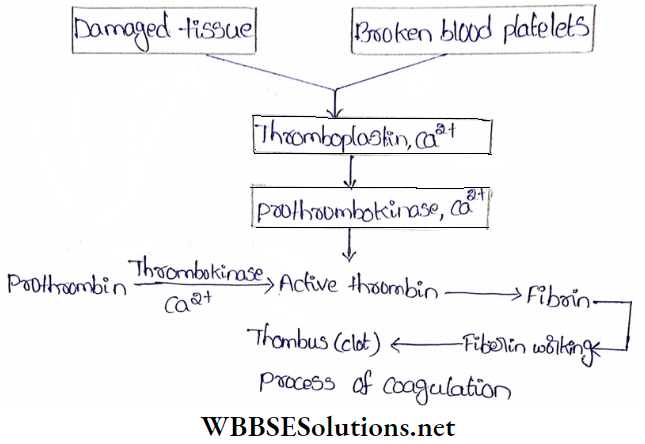
Question 10 Briefly describe the structure of the human heart.
Answer:
Structure of the human heart:
The human heart is a hollow, muscular, blunt-ended conical sac-like structure. It is externally covered with a bi-layered coating called pericardium. If a human heart is cut longitudinally, we can see the following anatomical features in it. Chambers of the heart: The human heart has four chambers. The upper two are called auricles or atria and the two, at the lower side, are the ventricles.
1. Auricles or atria: Auricles have comparatively thinner walls. According to the relative position, these are denoted as left and right atria. The two atria are separated by the inter-atrial septum.
2. Ventricles: These two chambers are located below the auricles. Ventricular walls are thicker and more muscular. A thick interventricular septum separates the two ventricles.
2 Valves of heart:
The left and the right atria are connected to respective ventricles with two openings, called left and right atrioventricular apertures. These two apertures are fitted with two valves. The right atrioventricular valve has three cusps (flaps), so it is called a tricuspid valve. The left one has two cusps, so it is called bicuspid valve or mitral valve.
The exits of the aorta and pulmonary trunk are fitted with two outwardly directed valves. These are known as aortic valve and pulmonary valve respectively. These are commonly called semilunar valves because of their half-moon-shaped cusps.
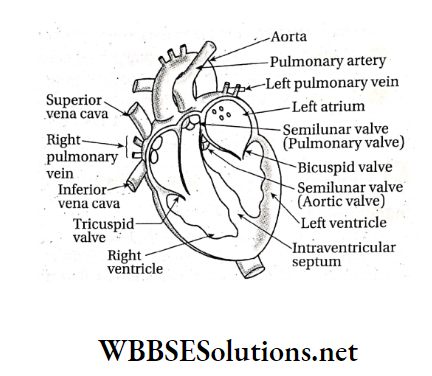
Question 11 Describe the structure of the pacemaker system of the human heart.
Answer:
Structure of the pacemaker system of the human heart:
The pacemaker of the human heart is made up of a few cardiac muscle cells, specialized to generate spontaneous impulses within the heart. This impulse is spread all over the heart and makes it beat continuously in a rhythm. These tissues are called the junctional tissues or pacemakers of the heart.
The main impulse-generating center of the heart is called -the Purkinje sinoatrial node (SA node), located near the junction of the superior vena cava and right auricle. It can generate 70-80 beats/min. The next center is the atrioventricular node (AV node), positioned at the right atrioventricular wall.
It can take over the charge from an inactive SA node and can generate 60-70 beats/min. SA node and AV nodes are interconnected by three pairs of internodal connectors. From the AV node, a bundle of junctional tissues comes down through the interventricular septum.
This is called the bundle of His. This bundle is also capable of generating about 50 beats/min. This bundle then ramifies into several branches and spread in the ventricular wall as Purkinje fibers.
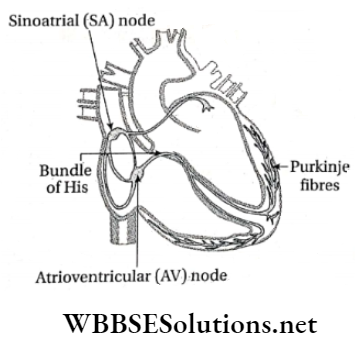
WBBSE Class 9 Life Science Solutions
Question 12. Briefly describe the course of circulation through the human heart.
Answer:
A course of circulation through the human heart:
The human heart beats spontaneously in a rhythmic fashion. Due to this contraction and expansion, blood is pumped through the blood vessels and circulates throughout the body. The contraction and expansion of the heart is called systole and diastole respectively. During systole and diastole, the following events occur in different chambers of the heart.
1 Diastole of auricles:
In this phase, the auricles expand, and auriculoventricular valves close. Pressure decreases in the auricles. Soon deoxygenated blood from the superior and inferior vena cava and coronary sinus enters into the right auricle. At the same time, oxygenated blood from pulmonary veins enters into the left auricle.
2 Systole of auricles:
As the auricles get completely filled, they contract. Pressure increases in the auricle. With this pressure, both tricuspid and bicuspid valves open towards the right and left ventricles respectively.
3 Diastole of ventricles:
Diastole of ventricles starts with the systole of auricles. With the opening of tricuspid and bicuspid valves deoxygenated blood enters into the right ventricle and oxygenated blood rushes into left ventricle respectively.
4 Systole of ventricles:
When the two ventricles get filled with blood, ventricular systole starts. So pressure increases inside these chambers. With this pressure tricuspid and bicuspid valves close with a jerk. With maximum ventricular pressure, the pulmonary and aortic valves open at a time.
Then deoxygenated blood from the right ventricle and oxygenated blood from the left ventricle are pumped out through the pulmonary trunk and aorta respectively. In the human heart, blood flows through two separate circuits.
The right portion of it carries deoxygenated blood and oxygenated blood flows through the left portion. In a normal human heart, the mixing of two different types of blood never happens. Therefore, the human heart acts as a perfectly double-circuit heart.
Question 13 Draw a line diagram of the L.S. of the human heart to show the course of circulation through it, with labeling.
Answer:
Diagram of the human heart:
Following is a labeled diagram of the L.S. of a human heart showing the course of circulation through it.
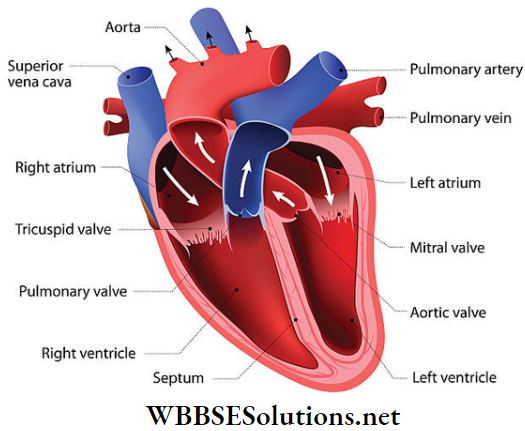
WBBSE Class 9 Life Science Solutions
Question 14 What is meant by double circulation? Show the path of double circulation with a schematic diagram.
Answer:
Double circulation:
In higher vertebrates like birds and mammals, the heart is four-chambered. Her blood flows in two separate circuits, one through the systemic path and the other through the pulmonary path.
This type of circulation is known as double circulation. It is called a double circulatory system since it has two loops. One is from the heart to the lungs and the other is from the heart to the rest of the body.
Diagram of the path of double circulation:
The following labeled diagram shows the path of double circulation.
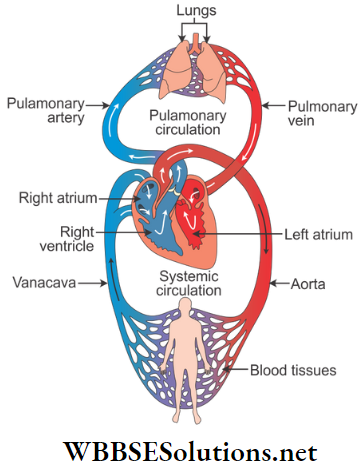
Question 15 Comparison among human RBC, WBC, and platelets.
Answer:
Comparison among human RBC, WBC, and platelets:
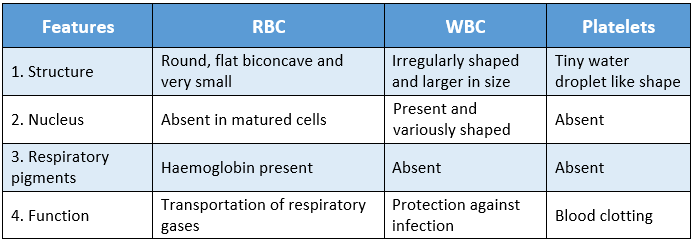
Question 16 Briefly describe the ABO system of blood grouping.
Answer:
ABO System of blood grouping:
Karl Landsteiner (1900) classified human blood into four groups depending on the presence of agglutinogen or antigen A, B, AB, O in RBC and agglutinin or antibody a, b, ab in plasma. This is known as blood grouping. The four human blood groups are A, B, AB, and O. The combinations of antigen or agglutinogen and antibody or agglutinin factors in RBC and plasma respectively in the four blood groups are shown below
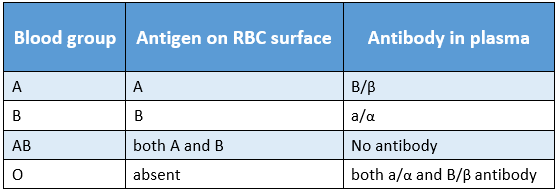
Question 17 Depicts the general composition of blood through a flowchart.
Answer:
Composition of blood:
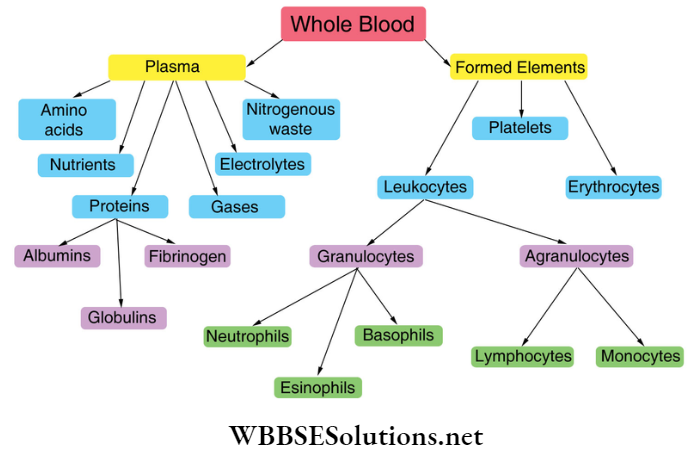
WBBSE Class 9 Life Science Solutions
Question 18. Write about the significance of blood grouping for transfusion. Represent the compatibility of different blood groups through a table.
Answer:
Significance of blood grouping for transfusion:
Transfusion of blood may be made directly from the donor’s body or from the preserved blood in the blood bank. Some precautionary measures are necessary for transfusion. These include compatibility tests (matching ABO blood groups), tests for Rh factor, etc.
If the donor’s blood does not match with that of the recipient, the RBCs are agglutinated and the patient suffers from several damages. Blood group AB has no agglutinin in plasma through its RBC contains both agglutinogen A and B. So, it can receive blood from all groups without agglutination.
This group is called ‘Universal recipient. On the other hand, blood group O has no agglutinogen in RBC through its plasma contains both agglutinin a and B. So it can donate blood to all groups without agglutination. Hence, this group is called ‘Universal donor.
Compatibility of blood groups:
Compatibility between different blood groups has been represented in the following table

Question 19 What is the Rh blood group system? State its significance.
Answer:
Rh blood group system:
The Rh blood group system is based on the Rh factor which was discovered by Landsteiner and Weiner (1940). In this system, blood is grouped on the basis of the presence or absence of a special agglutinogen or antigen called the ‘Rh factor’ in the RBC.
This antigen was first observed in Rhesus monkeys. Human blood having RBCs bearing Rh factor is called Rh positive (+) and blood without Rh factor is called Rh negative (-).
Significance:
If the blood of an Rh-positive donor is introduced into Rh negative recipient’s body then an anti-Rh factor is formed in the recipient’s blood within 12 days.
If then, the same donor’s blood is introduced into the same recipient’s body a second time, then the donor’s RBCs are agglutinated in the recipient’s body.
As a result, the recipient suffers from damage. So, it is essential to match the donor’s and recipient’s blood before transfusion.
WBBSE Class 9 Life Science Solutions
Question 20. Mention the name, position, and function/significance of different types of valves of the human heart.
Answer:
Valves of the human heart:
The main valves of the human heart are the Bicuspid or mitral, Tricuspid, Pulmonary semilunar, and Aortic semilunar valves. Other valves of the human heart are the Thebesian or Coronary and Eustachian or Caval valves.
